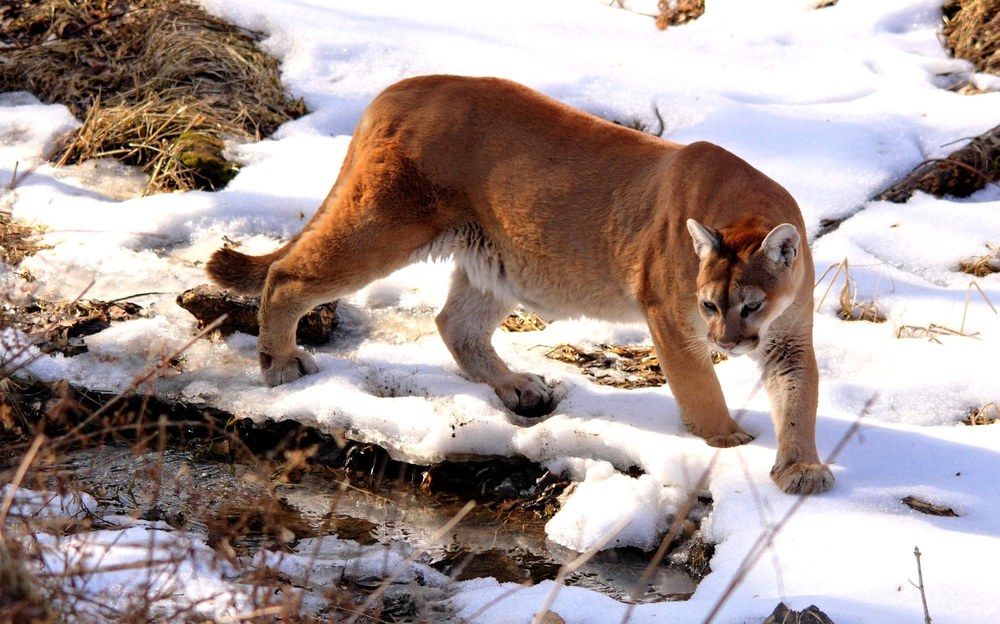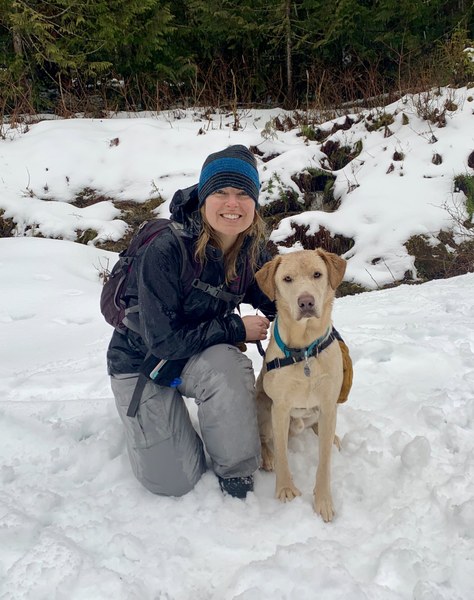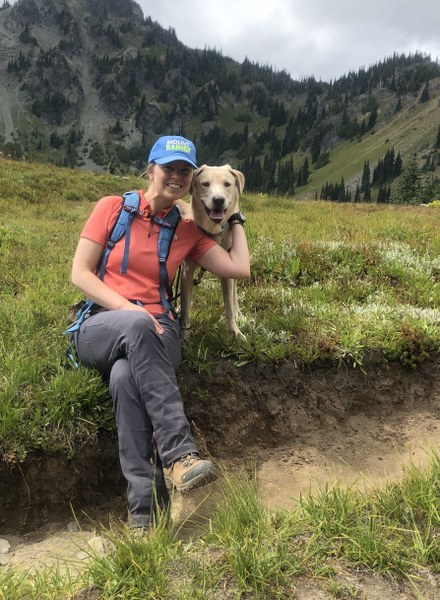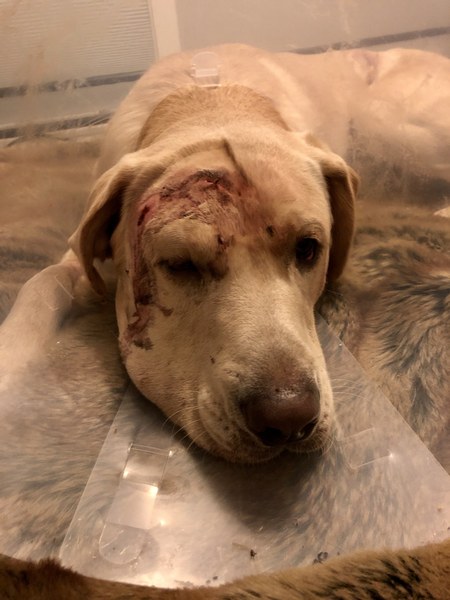
We’ve all experienced a moment of true fear. Your fingers grow cold and your stomach drops. Time slows while your mind and body prime to react, and all you can think is, “This is actually happening.”
As Mountaineers, we’ve been there. You can expect the unexpected in the outdoors: a loose boulder tumbling down a narrow gully being traversed, or foreboding clouds rumbling closer as you quickly finish summit snacks and reverse course down the mountain. Almost always, instinct and training move us to safety.
Then there are those rare occurrences many of us have only heard stories about. You never expect it to happen to you, and when it does, all you can do is accept it as your reality. And hope to escape unscathed.
Alison and Blue on a snow excursion. Photo courtesy of Alison Dempsey-Hall.
A walk in the woods
This past November during a family vacation to Roslyn, Washington, my sister Melissa and I decided to take a midafternoon hike to Cooper Lake with my 65-pound Labrador, Blue. Nestled in the heart of the Cascades, old growth forest and snow-capped mountains ring the pristine 120-acre lake. It was the perfect opportunity to stretch our legs and give the dog some exercise.
The path to the lake is well-traveled, and after passing a few other couples with dogs we were wrapping up the last mile to the lake. Taking in the scenery with Blue trotting in front on-leash, we were looking forward to the deep blue waters ahead. Then the unthinkable happened. We turned a bend in the trail and came face-to-face with a 130-pound cougar.
I imagine it’s what a car crash would feel like; you blink and it’s already happened. With Blue leading the pack, he was within feet of the cat, who didn’t miss a beat. In a second the cougar closed the gap, eyes locked on the dog. Neither animal moved a muscle. The cat latched onto Blue’s head and pulled him to the ground. Dinner was a bite away.
Alison and Blue on a backpacking trip to Sourdough Gap. Photo courtesy of Alison Dempsey-Hall.
Defending Blue
Quickly moving past fear, my fur-baby mama instincts kicked in big time. Using what we knew about deterring predatory wildlife, my sister and I did our best to make ourselves big. We stood tall, arms outstretched and yelling, slowly backing away from the cougar. Blue laid pinned on the ground by the cat, the leash still connecting us. I could only make it back a few steps before the lifeline was pulled taut. Still latched onto Blue’s head, the cougar slowly began dragging him into the brush.
Now standing 10 feet behind us, my sister was grasping for a new tactic. She grabbed a big branch and lobbed it at the cat. It proved to be our saving grace. Startled by the attack, the animal quickly snapped out of predator mode. The cougar released and ran off down the hillside, and I turned to see Blue inexplicably pop up out of the brush.
After the attack
Even with bloody head wounds, I could see my reliable trail dog still had his wits about him. We got moving, knowing that in any rescue situation (human or canine), if the injured party can walk themselves out you need to get down the trail. Blue’s resilience amazed me. Injuries and all, he trotted out of the woods as if it was just a really bad day at the dog park!
Although it felt far longer, the whole encounter lasted less than two minutes. Even given my proximity to the cat, we never made eye contact. The cougar was so fixated on the dog I'm not sure it even realized we humans were there.
Once back at the trailhead, it was time to take Blue to the vet to recover from the fight of a lifetime. With quite a few stitches and weeks of healing time, we were sure to take it easy for a while. Fortunately, he has since fully recovered, and his trusting exuberance hasn’t changed a bit. After enhancing my pack with a few animal-deterrent extras, we’ve hit the trails a few times since the attack. I’m thankful every day that we escaped with only superficial wounds and a scary story to tell around the campfire.
We are lucky it ended as well as it did, but also realize we had this outcome because we knew what to do. This included reporting the incident to the Washington State Department of Fish and Wildlife (WDFW), who is responsible for tracking incidents like this across the state.
Blue recovering immediately following the attack. Photo courtesy of Alison Dempsey-Hall.
Cougars in Washington State
While cougar attacks are rare, they do happen. According to the WDFW, there are approximately 2,100 cougars in Washington State. The agency said the last cougar attack in the greater Roslyn area occurred about four years ago, also against a dog. For humans, there have been 18 non-fatal attacks and two fatalities caused by cougars in Washington State in the last 97 years.
While cats will be cats, the cougar we ran into was more than curious - it was brazen. My sister and I were mostly in our own heads as we ambled up the path, and there’s no way a normal cougar wouldn’t have heard us coming with the crunch of twigs beneath our boots and the jangling of Blue’s tags. I’ve reminded myself that as with any living creature, there are exceptions to normal animal behaviors. In the wild, predators experiencing starvation or illness become less alert, or desperate. Could that have been part of the explanation?
It’s challenging to know, but what is clear is that territory can be scarce. With Washington one of only 13 states with a healthy cougar population, and the craggy expanses of our mountains one of the few places here they can roam freely, there are limited places for an adult cougar to go. A cougar’s territory can be anywhere from 20 to 640 square miles, depending upon the concentration of prey in its area. Female cougars often have smaller territories that overlap with that of both males and females, but male cougars face a different set of circumstances. With no hope of overlapping boundaries with other males, juvenile male cougars often search for hundreds of miles for a territory of their own. Because of this, they are more likely to come into contact with humans – and be hungry when they do.
Many outdoorspeople have heard stories of recreationists or joggers being stalked by cougars, though far fewer have come in close contact. My Uncle John, an avid outdoorsman and hunter for over 70 years, has said that in mountainous, heavily-timbered country with ample human activity, wild animals create separate game trails that often parallel our trails. They will be less than 100 yards uphill, just out of sight - hearing you, smelling you, and seeing you. Wildlife are usually just as invested in staying out of your way as you are of theirs.
I can’t help but consider how exponential growth in development and outdoor recreation in the Northwest has influenced cougar behavior in recent years. The influx of out-of-towners in what used to be quiet rural areas has transformed them into hubs of activity, with fewer and fewer places for these animals to roam free and undisturbed. Although I understand I’m unlikely to be hit by lightning twice, a few things have changed since that fateful day on the trail. I scan the hillside just a little more frequently, and I yodel from time-to-time so that no one is surprised to see us coming around the bend.
Information in this piece is courtesy of Washington State Department of Fish and Wildlife and Western Wildlife Outreach. For more information about cougars and how to respond to an encounter, visit Western Wildlife Outreach at westernwildlife.org.
How to prevent attacks and protect yourself and others
When we recreate, we are guests in the homes of wild animals. I view training not only as an act of self-protection, but as an act of respect towards creatures as we travel through their domain. After doing some research, these are the tactics that I use to prevent and be prepared for unwanted cougar encounters:
Prevention
- Keep dogs on-leash.
- Wear a bear bell.
- Keep bear spray easily accessible.
- Periodically call, “Yodel-ay-hee-hoo!” In other words, “Wildlife, I’m here! Don’t be startled.”
Response
- Get big: hold up trekking poles, hold up your arms, gather together, and pick up children.
- Get loud: Yell, "Hey cougar!"
- Don't scream – you want to show dominance, not fear.
- Back away slowly, but never run. It triggers predatory instincts in the cat.
- When in very close proximity, throw rocks and branches.
- If you are attacked by a cougar, fight back at all costs.
This article originally appeared in our Spring 2021 issue of Mountaineer Magazine. To view the original article in magazine form and read more stories from our publication, visit our magazine archive.
LEAD IMAGE OF Cougar Photo by NaturesFan1226, http://bit.ly/3tALh1x . ALL other IMAGES COURTESY OF Alison dempsey-hall
Add a comment
Log in to add comments.Alison, thank you for the article. Glad you're safe and Blue is fully recovered.
 Alison Dempsey-Hall
Alison Dempsey-Hall


